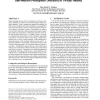Free Online Productivity Tools
i2Speak
i2Symbol
i2OCR
iTex2Img
iWeb2Print
iWeb2Shot
i2Type
iPdf2Split
iPdf2Merge
i2Bopomofo
i2Arabic
i2Style
i2Image
i2PDF
iLatex2Rtf
Sci2ools
114
click to vote
VRST
2006
ACM
2006
ACM
Simple user-generated motion cueing can enhance self-motion perception (Vection) in virtual reality
Despite amazing advances in the visual quality of virtual environments, affordable-yet-effective self-motion simulation still poses a major challenge. Using a standard psychophysical paradigm, the effectiveness of different self-motion simulations was quantified in terms of the onset latency, intensity, and convincingness of the perceived illusory self motion (vection). Participants were asked to actively follow different pre-defined trajectories through a naturalistic virtual scene presented on a panoramic projection screen using three different input devices: a computer mouse, a joystick, or a modified manual wheelchair. For the wheelchair, participants exerted their own minimal motion cueing using a simple forcefeedback and a velocity control paradigm: small translational or rotational motions of the wheelchair (limited to 8cm and 10◦ , respectively) initiated a corresponding visual motion with the visual velocity being proportional to the wheelchair deflection (similar to a ...
| Added | 14 Jun 2010 |
| Updated | 14 Jun 2010 |
| Type | Conference |
| Year | 2006 |
| Where | VRST |
| Authors | Bernhard E. Riecke |
Comments (0)

